| 1 | Greece’s deadliest snake |
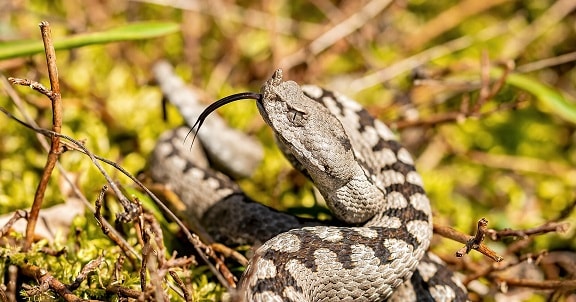
While UK citizens have to fight off adders, and Frenchmen are constantly stepping over asp vipers, Greece has its own main venomous terror: the nose-horned viper (Vipera ammodytes). This is a 65cm species which loves rocky areas, and is easily recognisable by the horn protruding from its nose. This snake is commonly dubbed the deadliest on European soil. There’s myths and truths alike, one being that Vipera ammodytes has the power to jump (false). A true fact is that their fangs are particularly long, at 1.3mm, and their venom possesses neurotoxins, cytotoxins and haemotoxins alike.
Nose-horned vipers have a large territory, though nowhere near as huge as the adder, which has the largest west to east distribution of any snake (Mongolia to the UK). Nose-horned vipers are particularly common in Greece, Bulgaria, Serbia, and Macedonia. To the northwest, they’re found in rocky alpine regions of northeast Italy and southern Austria (Carinthia). To the northeast, they’re believed to reach the extreme south of Ukraine, near the port city of Odesa.
Nose-horned vipers can be found in western Turkey near the Black Sea, and then there’s a random pocket in Armenia to the east. This is either an isolated subspecies, or an independent species altogether called the Transcaucasian viper (Vipera transcaucasiana), as the debate still rages.
| 2 | Horn facts |
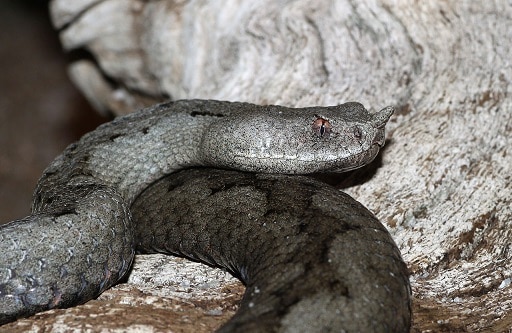
Nose-horned vipers are easily recognisable by their rhino-like nose. Adders lack this, asp vipers lack this – the only other family member to have a horn like this is Lataste’s viper of Spain (Vipera latastei), and this is far wimpier. Both male and female Vipera ammodytes possess this horn.
Unlike the Saharan horned viper, which has a single enlarged scale, Vipera ammodytes horns consist of 6-17 scales stacked on top of each other. There’s no risk of being spiked, as the horn is soft and flexible to touch. They’re not an offensive weapon – in fact, the exact purpose is unknown. It’s possible that they’re used purely for intimidation, perhaps if a bird spots them in silhouette form.
The horns vary in angle with each snake. Some are nearly vertical, while others face forward horizontally, and then there’s everything inbetween. It’s theorised that northern nose-horned vipers have more forward facing horns than those in the south, where they stand vertical.
Size is another difference between locations. Northerly Vipera ammodytes are generally larger, with the current record being found in southern Carinthia, Austria, which measured 110cm. The second longest was a full 19cm shorter, at 91cm, and was also found in Carinthia. The first one must have been a true freak of nature. Meanwhile, the longest in Serbia measured 84.3cm, displacing a previous record of 80.0cm. These were all males, as males outstrip females in this species.
| 3 | Most common in rock fields |
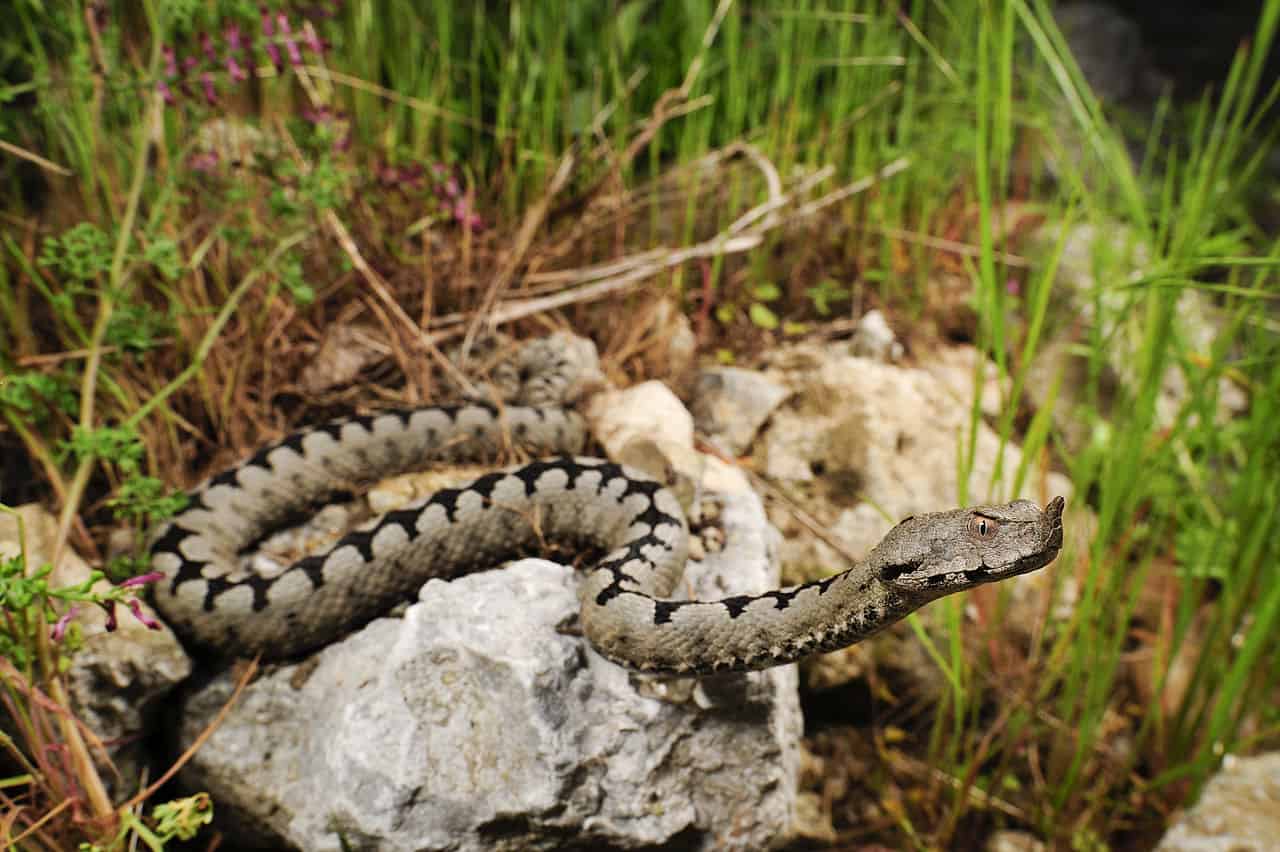
Nose-horned vipers have a weird name in Latin, as ammodytes translates to sand burrower. It’s also referred to as the sand viper commonly, yet nose-horned vipers almost never appear in sandy habitats. They were originally named in the 1750s, and “Libya” was mislabelled as a population, when they’re found nowhere close to North Africa. It’s theorised that they were accidentally lumped together with the Saharan horned viper, which appear on sand dunes.
Their favourite habitats of all are dry hillsides with an abundance of rocks, often with thorny bushes. Nose-horned vipers can also appear in manmade locations if there’s an abundance of rocks, such as villages and vineyards with stone walls. They occasionally appear in swampy land, but only when bordering a drier forest.
Nose-horned vipers are more calm than their terrifying facial expressions suggest. If you walk past their rock shelter, they’ll usually not react or show any signs of alarm. Researchers have managed to move them with snake hooks and produce no aggressive reaction. Rocks and dry (though not arid) habitats have the closest correlation with Vipera ammodytes.
| 4 | Death is a possibility |
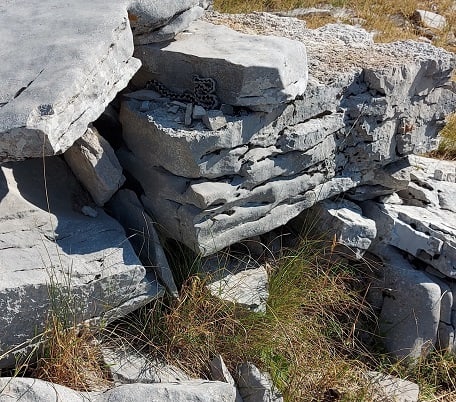
Nose-horned vipers are commonly dubbed “Europe’s deadliest snake”, but it’s more complicated than that. While they’re definitely highly ranked, they cover such a large territory, from Italy to Armenia, that there’s inevitably variations in venom. The adder has received an LD50 score as high as 0.11mg, while French asp vipers cause a death every few years. Vipera ammodytes have LD50 scores ranging from 0.19-2.0mg, depending on location and method used. In a study on Greece involving 147 snakebites, most of which were Vipera ammodytes, there were no deaths.
In practise, nose horned viper bites are usually survivable, but one feature is the large variety of effects they have. They cover most of the snake bases: hemotoxic, cytotoxic, and finally, neurotoxic. Vipera ammodytes venom is rich in phospholipase A2s with neurotoxic effects, including a rare one: ammodytoxin.
Neurotoxic symptoms include drooping eyelids (ptosis), trouble swallowing, a distorted voice, eye muscle weakness, and overall muscle weakness. Another study analysed 542 venomous snakebites from Croatia, recorded in hospitals over 21 years. The vast majority were caused by nose-horned vipers, with a small percentage from adders. Of the total, 16% led to neurotoxic symptoms.
| 5 | 100% chance of swelling |
Two deaths were found in the study, which are two of the few nose-horned viper deaths on record. Both were soldiers on military exercises in southern Croatia, in 1993, meaning that they were far from medical assistance. The first was bitten while in a sleeping bag, and the second was bit on the armpit while resting his arm on an old stone wall.
Overall, 45% of bites happened to agricultural workers, such as people harvesting or planting. 10% happened to cattle farmers, 7% happened to people gathering wood, and 5% happened to people foraging, e.g. for blackberries or asparagus. Another 12% happened to children playing outdoors. Bites were most common from April to October, mirroring the snake’s active season, and May was the single busiest month, with 119 of the total 542 bites.
Every single patient experienced swelling. This varied from barely noticeable, to massive swelling that covered the limb and reached the core of the body. 46.8% of patients experienced extensive edema (swelling). Skin discolouration and spontaneous bruises (ecchymosis) were found in 92.2% of patients. Again, this varied from barely noticeable, to reaching the trunk. Haemorrhagic blisters affected 13% of patients, while necrosis wasn’t especially common, at just 3.8%.
| 6 | Get ready to vomit |
Then there was the internal symptoms. Fever ruled the roost, with 60.8% of viper victims experiencing it. The most serious symptoms recorded were liver damage (4.4%) and kidney failure (4.6%), which were still survivable. Nose-horned viper bites also had a strong link to gastrointestinal symptoms, including vomiting and diarrhoea (22.5% of patients). While rarely fatal, a Vipera ammodytes bite can be a bumpy ride.
The final verdict was that of the 542 snakebites, 15.1% caused minor symptoms, 40.5% mild, 26% moderate, and 18% severe. The length of hospital stay for those categories was 2.6, 5.8, 8.9 and 10.9 days respectively.
The study even had details on how patients attempted to save themselves. 4.6% of vipers victims tried to suck the venom from the wound, copying the old John Wayne rattlesnake strategy. 16.4% applied a tight band while 4.6% were simply classed as “incision”. One reassuring statistic was that 94% of viper victims received antivenom within 4 hours of the bite. If you’re bitten in Croatia, and probably most other places, it’s very easy to find the hospital vial of liquid which will save you.
| 7 | Surprisingly muscular |
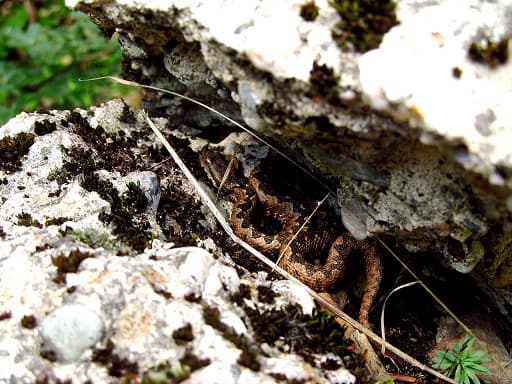
Vipera ammodytes is a tactical snake which repurposes its venom for different animals. Studies find that their venom is clearly most targeted against mammals. Humans rapidly experience debilitating symptoms, as do mice and birds. Small reptiles take longer to die, while frogs can survive a bite, despite being pocket sized. It’s theorised that neighbouring snakes like the grass snake or smooth snake are completely immune.
According to keepers, Vipera ammodytes is extremely easy to feed in captivity. Fling them pre thawed or live mice and they’ll swallow without ever requiring force feeding. A couple would only eat live mice or vice versa, while one snake randomly refused to eat for 1-2 months every so often.
Seasoned keepers have one tip with nose-horned vipers: never grab them by the neck! Never pin them either, as Vipera ammodytes has surprising muscular strength for a non-constrictor, which allows them to break free. They’ll then turn their rising anger towards you.
| 8 | Males versus females |
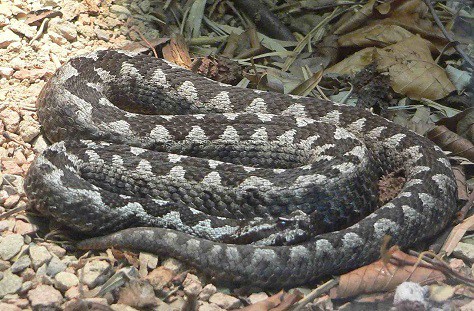
Vipera ammodytes is one of the easiest European vipers to separate males and females. The rules aren’t 100% consistent, but males are a stonier grey, with more highly contrasting patterns. They have a very dark zigzag running down their spine, and they have far vivider dark lines on their flanks. There’s also a dark V-shaped marking on the back of the head.
Overall, the face is far more detailed in males. There’s an extremely dark postocular stripe, beginning behind the eye, and the face is adorned with subtler lines and markings. Meanwhile, a female’s face can have no patterns, with a plain brown colour. The spine zigzag is in place, but less vivid, while the stripes on their flanks are muted and barely visible.
A female’s body is noticeably browner, and some have copper or brick red tinges. Both genders have the namesake horn. Males are not only darker, but lighter, with some virtually white patches between the zigzags. The sharp pattern contrast is the best key for identifying males.
| 9 | Island populations are shorter |
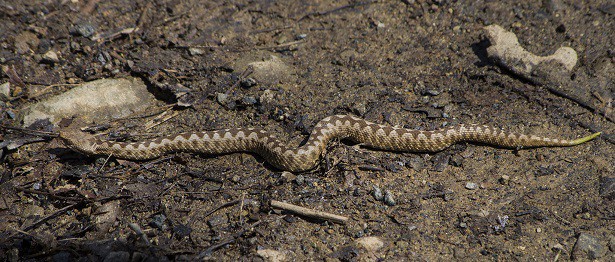
One study on nose-horned vipers analysed Golem Grad Island, found in Lake Prespa, Macedonia. This is a notorious snake island, which is crawling with dice snakes, with cursed treasure said to lurk in chambers below the forested walkways. It was found that nose-horned vipers here were 20% shorter than those on the mainland. The longest male measured 66.4cm, while the longest female measured 53.6cm.
Meanwhile, mainland snakes were analysed at 10 sites across Serbia and Macedonia. The longest male discovered measured 83.4cm, while the longest female measured 72.8cm. The island snakes were incapable of breaking beyond the mini me barrier.
Food supply was one logical reason. Golem Grad island hosts just one native mammal, the European rabbit, which is too large to swallow. Its native reptiles include the common wall lizard, which made up 70.6% of prey. Mediterranean banded centipedes comprised 20.3% of prey, while other meals included a couple of newborn rabbits and small birds.
Mainland Vipera ammodytes had access to a buffet of wonders, and their diet consisted of 62.0% mammals and 35.2% reptiles. They only consumed one centipede, so this was probably a desperate meal for the island-dwellers. The island vipers were less commonly observed with a recent meal in their belly.
| 10 | Diet: mammals and maybe lizards |
Most diet studies find a mixture of lizards and mammals, but some leaning more heavily one way. A study from the Carnac alps of northeast Italy found that juveniles ate 100% lizards. This decreased to 82.2% as sub adults, and plummeted to just 9.5% as adults. Meanwhile, they ate zero mammals as juveniles, which rose to 17.8%, followed by 75.1% small mammals in fully bloomed adulthood.
A Bulgarian study tested two locations: southwest Bulgaria and the rocky, sweeping Thracian plain and its surrounding hills. Mammals ruled in both locations, mainly rodents. They comprised 61% and 86% of the diet respectively, while lizards made up 23% and 12% respectively. The nose-horned vipers fed exclusively above ground rather than in deep underground networks. The ladder snake is one sneaky species that loves to sneak into dark burrows, but Vipera ammodytes is above such tactics. The nose-horned vipers were fully diurnal, rather than nocturnal.
Nose-horned vipers vary their diet based on location. Their specific prey include Horvath’s wall lizard, bank voles, and the wood mouse (Apodemus sylvaticus). The latter is already a confirmed prey of their cousin Lataste’s viper (Spain).
